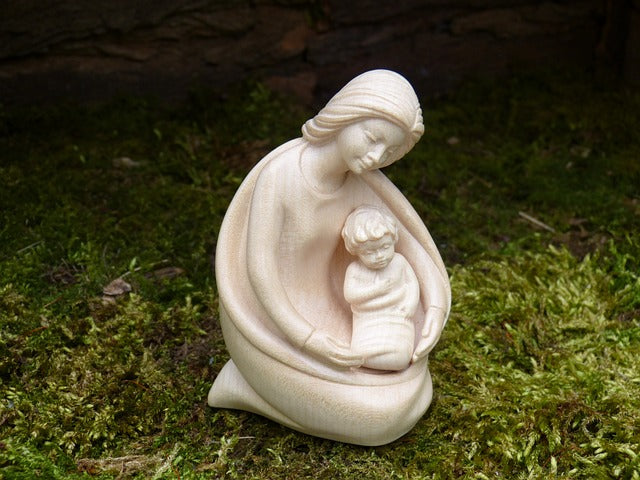The heartbreak of the blessed Mary
If the Christmas season had a favourite Bible passage, you’d have to say it was Luke chapter 2, wouldn’t you? Although the first half of the chapter gets a lot more of the attention—it records Mary and Joseph’s travel to Bethlehem, the birth of the baby, the swaddling cloths, the manger, and the famous angels and shepherds. In other words, it has all the elements loved by kindergarten nativity plays.
But I could count on zero hands the number of nativity plays I’ve seen in which Jesus is presented as a baby in the temple and then upsets his parents as a almost-teen by going missing.
So let’s take a minute to think about those two events in the second half of Luke 2 and see what we can learn from them. Are the two events connected to each other somehow? And how do they connect to the rest of Luke’s account?
Jesus presented at the temple
Mary and Joseph bring their infant son to the temple, as required by the law (2:22–24). But it’s their encounter with Simeon and Anna that becomes the focus. Both these faithful Jewish people have been given an insight about the special place this baby has in God’s plan. This child is fulfilling God’s promises for “the consolation of Israel” and “the redemption of Jerusalem” (vv 25, 38). He is the long-awaited Christ (v 26). Salvation is arriving in him—a salvation which is going to fulfil the promise that God’s blessing will also flow to the Gentiles (vv 30–32).
This maps out for us how the beloved Christmas story is going to develop into the gritty gospel story—the good news that this baby will be God’s eternal king, and is about to be enthroned and his kingdom inaugurated.
The way Jesus is going to take up this Messianic role is still somewhat mysterious. But Simeon knows something about it. He refers to the opposition Jesus is going to encounter and the division he will create, and he has this warning for Mary: “a sword will pierce through your own soul also” (vv 34–35).
Mary is a blessed mother, privileged to bear in her womb the consoling and redeeming Messiah (1:28, 30–33, 42, 45, 48). But her journey is going to involve maternal heartbreak.
Jesus the lost and found son
Luke then jumps forward twelve years, and we once again find Jesus in the temple with his parents. That’s obvious continuity and connection with the previous event. And we know that Luke is not writing a ‘random’ account; it’s an “orderly account” (1:3). So I wonder why he has put these events back to back?
Many people get a bit distracted from looking for a connection by noticing the first major claim Jesus makes about himself: that God is his “Father” (2:49). That is indeed a remarkable and significant claim. It affirms the claims already made about Jesus’ identity in Luke by Simon (v 26), the angel (1:35, 2:11), Gabriel (1:32) and Zechariah (1:76).
But let me put forward a suggestion about Luke’s purpose in recording this story of the lost and found boy Jesus. See what you think.
Remember, Mary has just been told that, while she is indeed blessed, a sword will pierce her maternal heart. And is there anything more heart-piercing for a mother than the loss of a child?
Luke goes straight from that previous temple event in which she is given that warning by Simeon into a new temple event in which she (temporarily, as it turns out) loses her son. Does this foreshadow the future event in which she will lose her son again—this time more seriously as he is crucified?
Is that a stretch?
Maybe. Perhaps you’ll tell me it is. What initially triggered my thinking was verse 46. Luke records a seemingly minor detail: “After three days they found him …” Does that ring any bells?
Mary lost her son for three days, and then, much to the relief of her “great distress”, he was found (v 48). Was she getting a foretaste through this event of her heart being pierced at Jesus’ crucifixion? And of having him rise again on the third day?
But there’s another parallel too. Just as the resurrected Jesus challenged his followers for their failure to understand the mission he had been given (“was it not necessary that the Christ should suffer these things and enter into his glory?”, 24:25–26), the 12-year-old Jesus similarly challenged his parents after they found him (“Did you not know that I must be in my Father's house?” or “... about my Father’s business?”, 2:49).
It’s all planned out. Mary needed to understand that the piercing of her heart was part of the pre-ordained package of her blessedness. Her Son would be lost and she would be greatly distressed. But although she doesn’t know it yet, he won’t be lost forever. He will be restored after three days.
In other words, Easter inevitably comes after Christmas. That’s the mission pathway Jesus was on. It was necessary for Jesus to be lost and three days later found. Heartbreakingly, this was the path he had to take to enter his kingship and achieve our salvation.
Thank God he did.













